AMD Kaveri Review: A8-7600 and A10-7850K Tested
by Ian Cutress & Rahul Garg on January 14, 2014 8:00 AM ESTDrawing Performance Conclusions
As I progressed through the testing for this review, I became aware of trends in two things: absolute performance, in terms of numbers, and generational improvements across platforms. With AMD moving the Bulldozer based architectures from Piledriver in Trinity and Richland to Steamroller in Kaveri, the base CPU design has had a relatively long run in order to be optimized to the limitations on the CPU side. Obviously AMD has also had a chance to change the lithography node in there as well, and as such has optimized for design rather than performance. This matters a great deal when we look at the power banding (45W, 65W, 95W) and performance in each segment.
In order to display just how much Kaveri has grown in relation to the previous generations, I processed our mountain of data to show graphs where percentage gain against the older generations really does matter. As mentioned previously in this review, it all depends on whether the software can take advantage of the new features afforded by the architecture. In this review we have spent a lot of time discussing advantages for Kaveri in terms of compute (HSA, hUMA, hQ) and gaming (Mantle, TrueAudio), but some of these are still a little way off for software integration. So what does that translate to if you are looking for an APU today – does Kaveri still expand its wings with the integration of the GCN architecture, or does it lag behind due to the lithography node no longer being optimized for frequency. The proof is in the results.
IGP Gaming, 1280x1024
For the 100W APUs at 1280x1024, there is almost no movement between the Richland and the Kaveri APUs, except for Company of Heroes which would seem to leverage the extra SPs more than the MHz available.
45W APUs are clearly in vogue at 1280x1024, each of them providing a good bump over Richland.
IGP Gaming, 1680x1050
1680x1050 sees more benefit for the 100W APUs, but the 45W APUs still show big leaps.
IGP Gaming, 1920x1080
At 1080p the effects are more pronounced all around.
CPU Timed Benchmarks
Unfortunately the CPU timed benchmarks at 100W are bit over the place. Here we are dealing with an IPC gain but MHz deficit, and each benchmark has a different way of dealing with it. For Agisoft, MHz wins, but for Xilisoft, the Kaveri improvements work out well for the system.
At 45W the situation is a lot more clearer, and the newer APUs have the advantage, especially in Adobe After Effects.
CPU Score Benchmarks
45W still makes the biggest jump when it comes to score based CPU benchmarks.
IGP Synthetics
I never like putting much thought into the synthetic results – here both the 100W and the 45W range are showing good improvements all around. 3DMark 06 has the most trouble getting improvements as it relies more on the grunt, rather than the features that Kaveri affords.
IGP Compute
Off the bat we can see just how much of a difference the Kaveri GPU Compute can make over previous APUs. This is still without hUMA fully being in effect while we wait for a proper driver and software stack to become available.
Up to a +222% boost from Kaveri is amazing for a 45W part.
AMD vs Intel
For a little tete-a-tete, putting the 65W Iris Pro up against the 65W Kaveri seems like a good idea. To add to the mix, due to the extreme price difference of Iris Pro in this equation, we also add the 95 W Kaveri for comparison.
It is interesting to note that at the lower resolutions the Iris Pro wins on most benchmarks, but when the resolution and complexity is turned up, especially in Sleeping Dogs, the Kaveri APUs are in the lead.


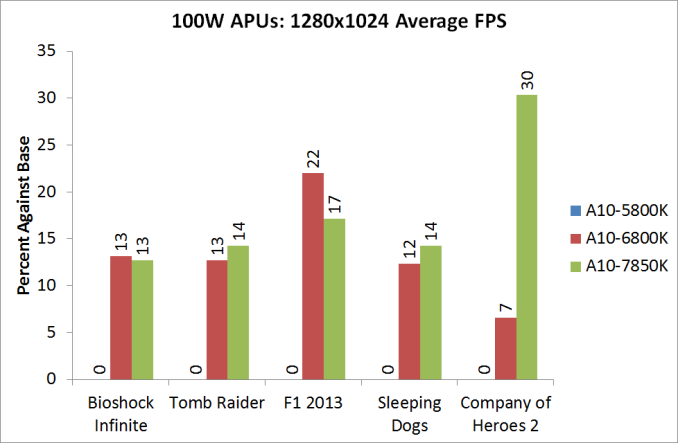
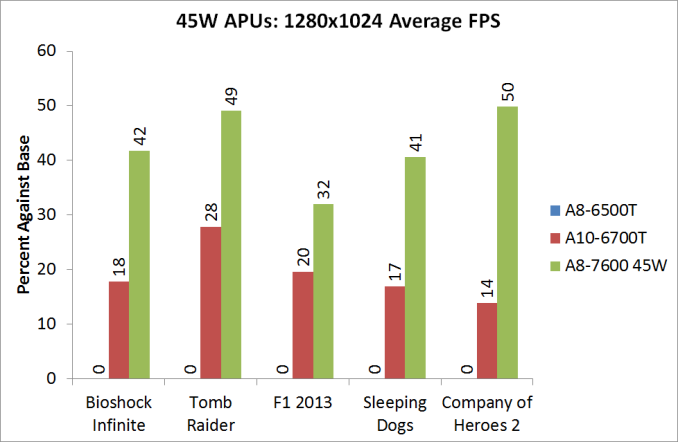
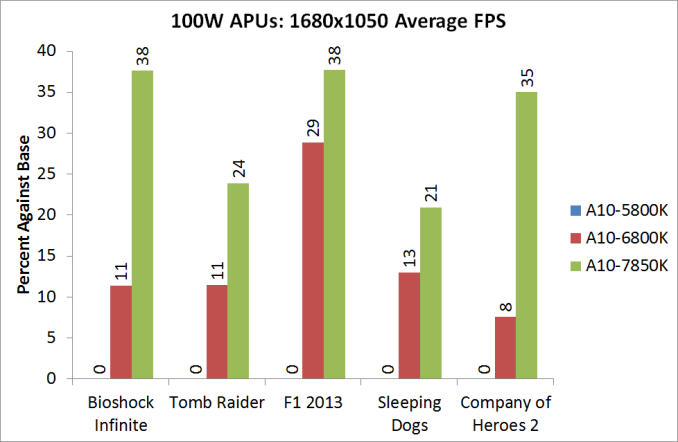
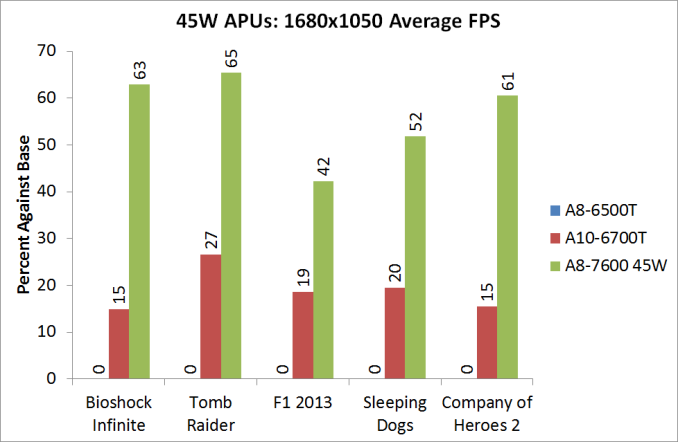
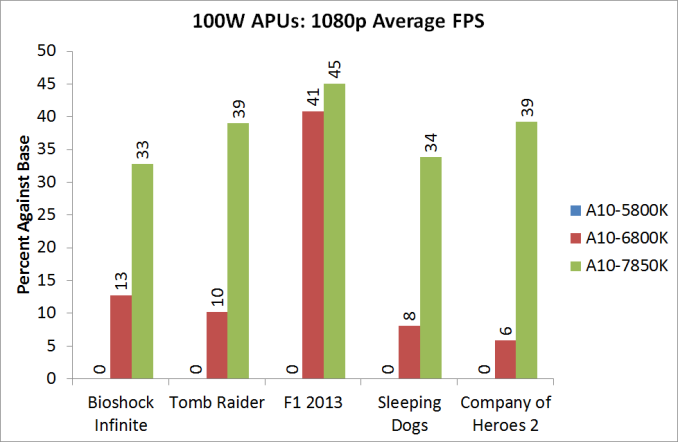

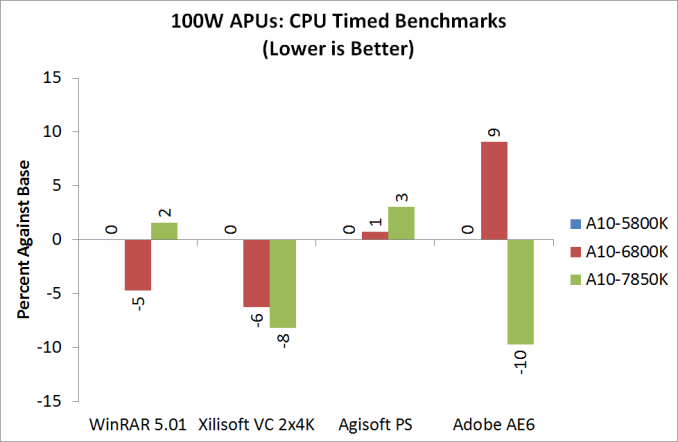
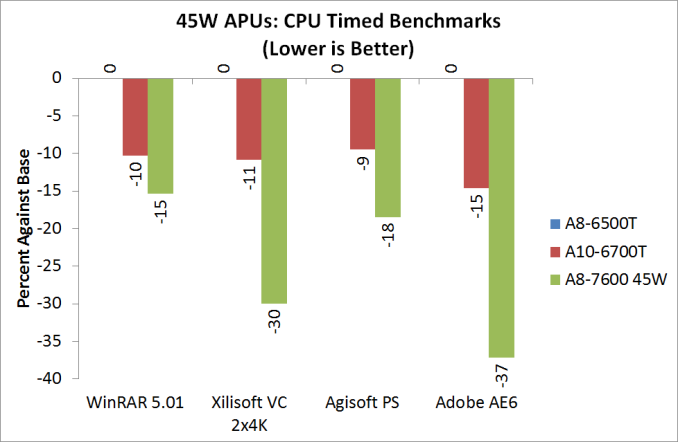

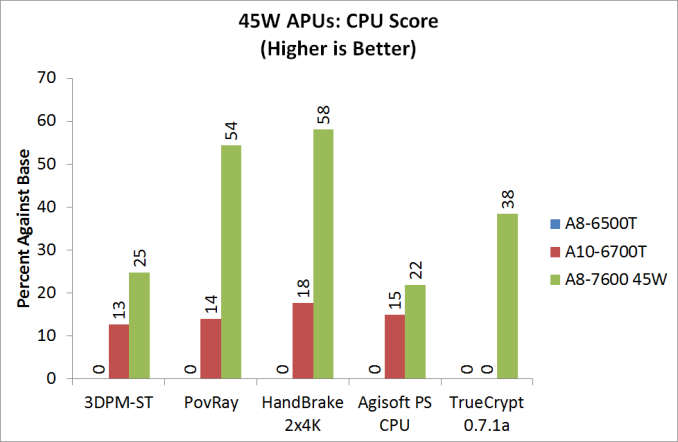
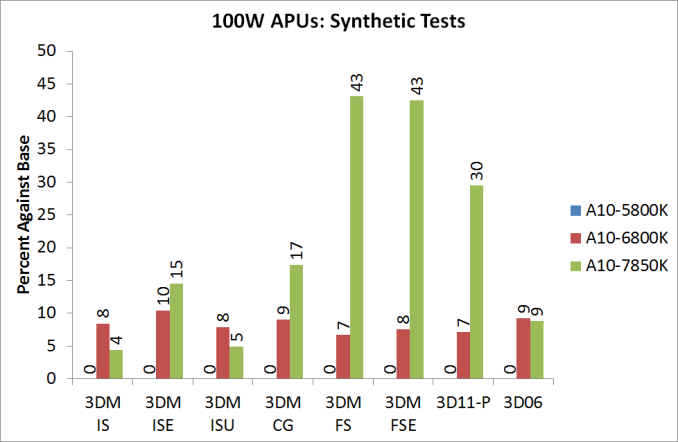
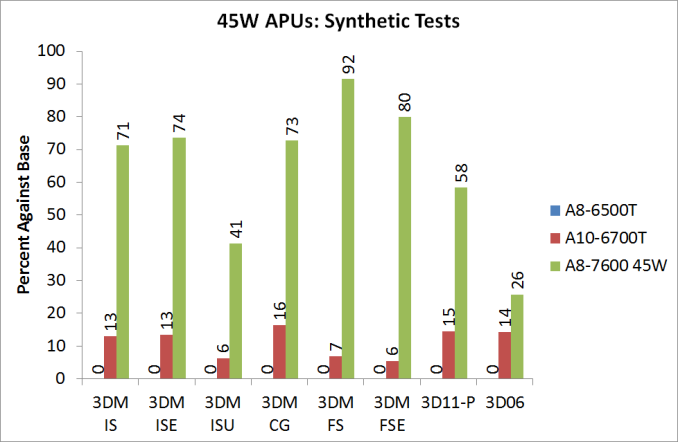
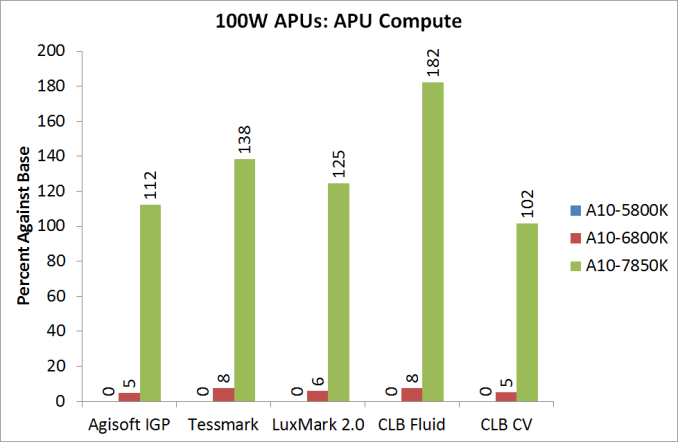

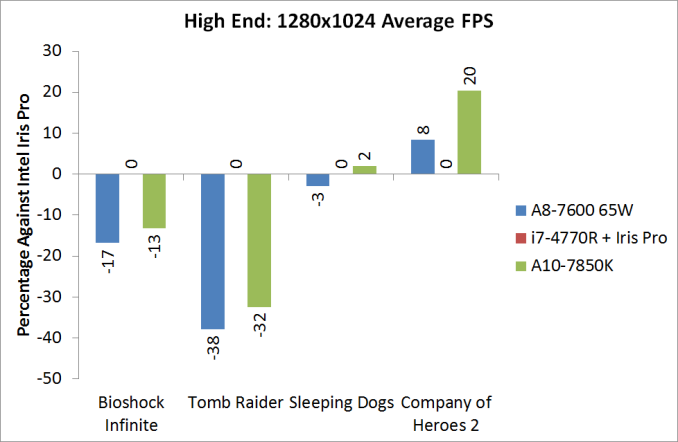
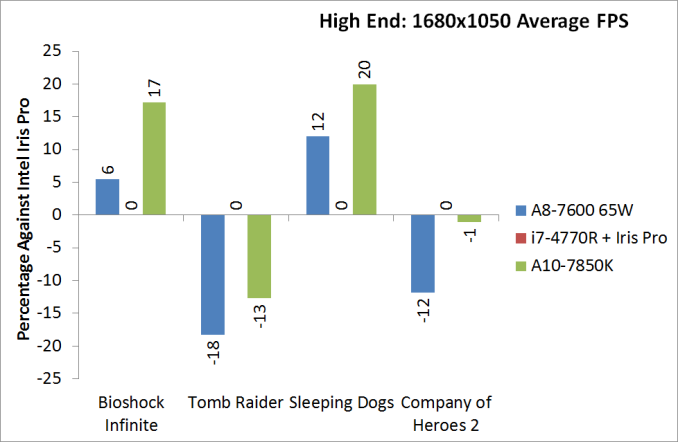
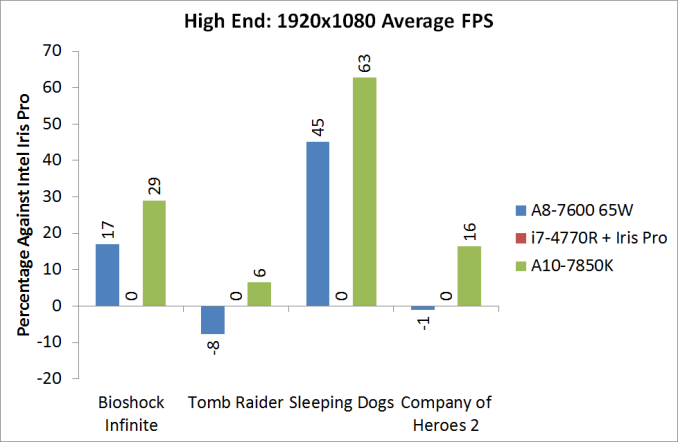








380 Comments
View All Comments
Fox5 - Wednesday, January 15, 2014 - link
There's also the issue of the Iris Pro's 128MB edram. At a certain point, it probably is insufficient for the settings and resolution.BSMonitor - Wednesday, January 15, 2014 - link
Power consumption numbers?? Interesting to see what adding that many transistors (particularly 128 GPU cores did to those)Da W - Wednesday, January 15, 2014 - link
242 comments so far. Whatever people say, AMD still interests a lot of people and they have a future ahead of them.thomascheng - Wednesday, January 15, 2014 - link
Lets hope they do well, or we will be stuck with buying $1000 Intel CPUs and Nvidia GPUs.TheJian - Wednesday, January 15, 2014 - link
"For casual gaming, AMD is hitting the nail square on the head in its quest for 1080p gaming at 30 frames per second, albeit generally at lower quality settings."Maybe if they'd said for 1280x1024 gaming your comment would be true. Most of the games have mins at 1080p well below 20, and some even avg below 30. This resolution is NOT playable on these crap chips. Buy a vid card and Intel. Period. I really thought these would be faster, but then the downclock due to process happened. Gains in games where you are STILL unplayable isn't a gain. It is a waste of space to benchmark things you can't actually play at. I would rather have seen a dozen games benched at 1280x1024 and a few you KNOW you could run above 30fps at 1680x1050. 1080p here was pointless. AMD should be derided for even mentioning this res with so many games not even playable at avg fps never mind what happens when you click the MIN button in your charts.
Discrete clearly has long legs, as anyone building one of these machines with the new APUs will quickly realize they need to buy discrete to enhance their gaming. I really don't think the dire situation here at 1080p will change until 20nm or more, where you may at that point have MORE games that CAN run 1080p ok, vs what you see here where it's just a joke today.
The games don't even look the same when turning off every feature possible in the game just to hit 30fps. Do you want your games to look like a nintendo 64, or a PC? They should have grown the die a bit for more gpu, so at least 1680x1050 would be pretty good. I don't see AMD making money on cpus for 2yrs :( That means consoles + gpus have to hold the company up and that won't be enough to keep up with R&D in mobile, gpu, cpu. Consoles sold 7mil so far, so at $10-15 per chip ($100 price? per console assuming 15% margin? if they even get that) we're talking about a max of 105mil profits from consoles for the quarter. If they don't keep selling like it's launch month for the next 12 months I see them slowly getting weaker. They owe GF 200mil, so 4 of these console quarters would be ~400mil which is 1/2 blown on GF fines, and the other 200mil goes to interest on their huge debt each year. They need to make some REAL money on cpu/gpu/mobile or this never gets better right? We know cpu is basically out for 2yrs as they say in this article. OUCH. So gpu/mobile has to make something in those two years or this just gets worse and drivers etc will see more phase 1, 2, 3 fixing crap for ages.
The only impressive thing I saw here was Mantle perf claimed by AMD in BF4. But how many times can you afford $8mil to get this done? I'm sure they amped things up for the first time showcase BF4, but how many times can you even afford $2-4mil for this stuff? And then do you get what the dev said in the AMD APU show (only one BTW), a 20% not being unreasonable for your efforts? Far below $8mil for apparently 45% in BF4 right? Devs will opt for the 2weeks to transfer a game to MOBILE first as NV showed can be done with any openGL game (all ps3, ps4 games, many pc games etc) like Serious Sam3 and Trine2 (most of the time according to anandtech was spent on controls, NOT the porting). Unreal 3 engine ported in 4 (yes...FOUR) days by epic/mozilla and it only took 10 people or so. Dice said 2-3 months on mantle. Devs might do 2 weeks just for more sales to a 1.2B unit market on mobile, they will need PAYMENT to do it for Mantle which gets ZERO extra profits (only makes people happy they bought AMD, no extra cash right?). I really hope ARM takes off on desktops, because we currently have an Intel only race and need someone with CASH to fight them. Bring on K1 (and all it's enemies) and all the games for mobile this will create (ported or new, I don't own a ps3 so I'd buy some of those ported that I can't get now). Since we have no real x86 competition any more we need ARM to pick up AMD's slack.
Novaguy - Wednesday, January 15, 2014 - link
Its going to depend on the settings; other reviewers who did 1080p + low to medium settings demonstrated playable frame rates for the a8 but not the intel igps.mikato - Wednesday, January 15, 2014 - link
Ian/Ryan - This seems wrong - "For the 100W APUs at 1280x1024, there is almost no movement between the Richland and the Trinity APUs, except for Company of Heroes" under "IGP Gaming, 1280x1024". In this particular graph, it shows an improvement from Trinity to Richland and then not much improvement from there to Kaveri, except for Company of Heroes.Ryan Smith - Wednesday, January 15, 2014 - link
Noted and fixed. Thank you.tekphnx - Wednesday, January 15, 2014 - link
Looks like a pretty nice improvement for its intended market, namely the HTPC and casual gaming crowd. Calling the onboard GPU decent at 1080p is a laugh though, as other people have said. For 720p, sure, but not 1080p.Prices have shot up from the previous generation, which is unwelcome. And I very much lament the omission of Steamroller from the FX roadmap as an FX owner myself. AMD shouldn't abandon FX... the least they could have done if they're abandoning FX is to include a 6-core Kaveri part at the top end, but it looks like that's not materializing either.
zodiacsoulmate - Wednesday, January 15, 2014 - link
first 4 pages are way better than the last 4 pages :) anyway a great article i read like half an hour